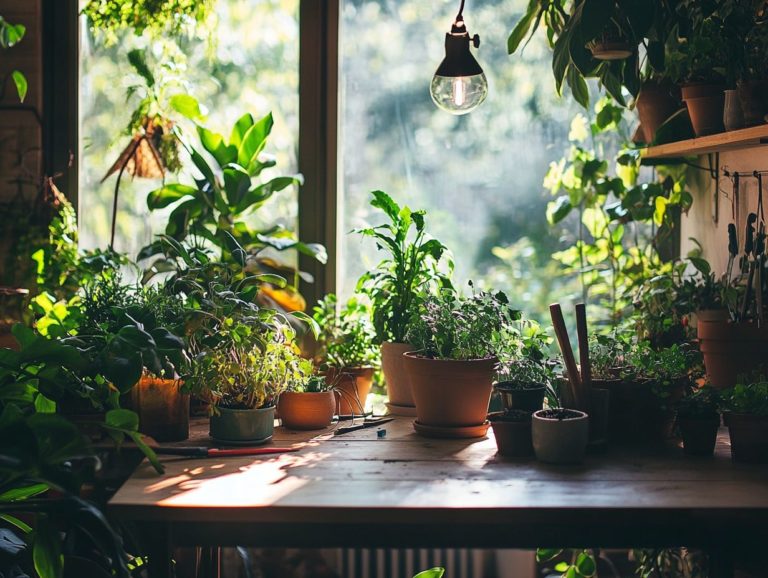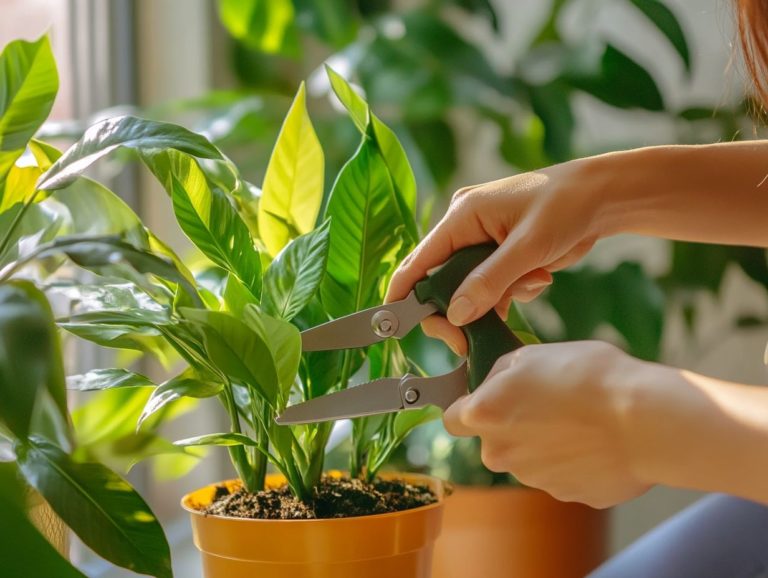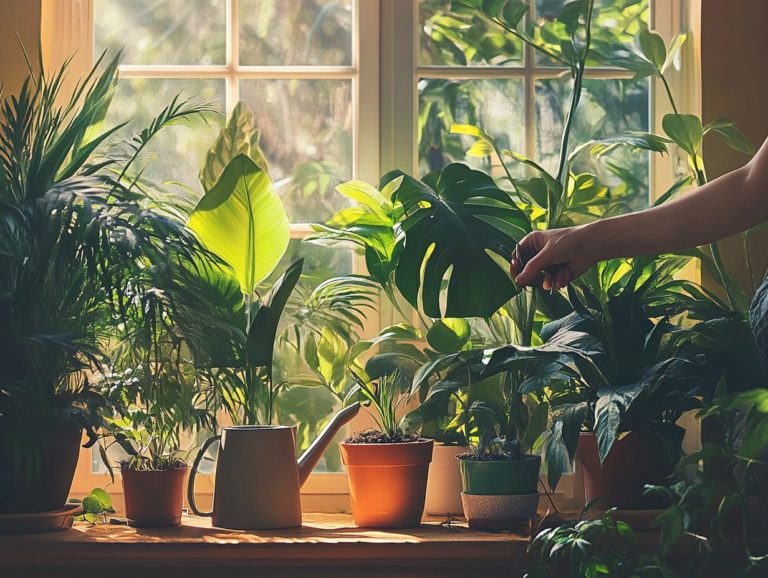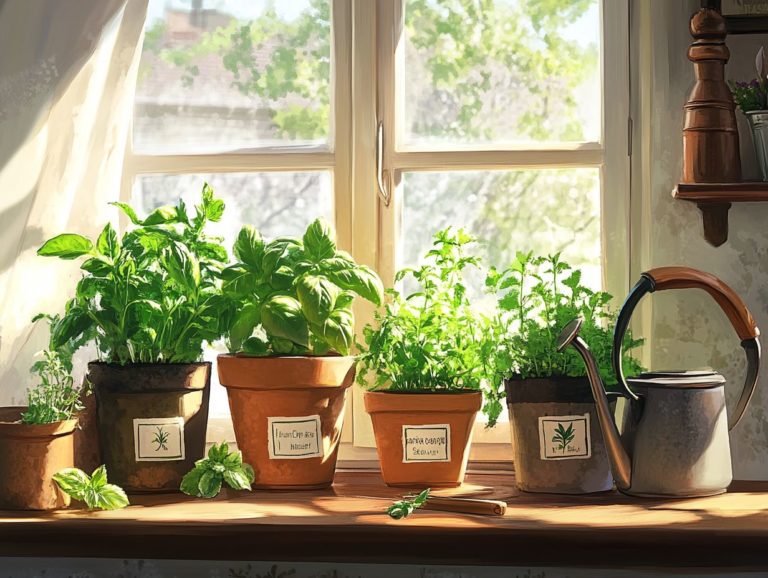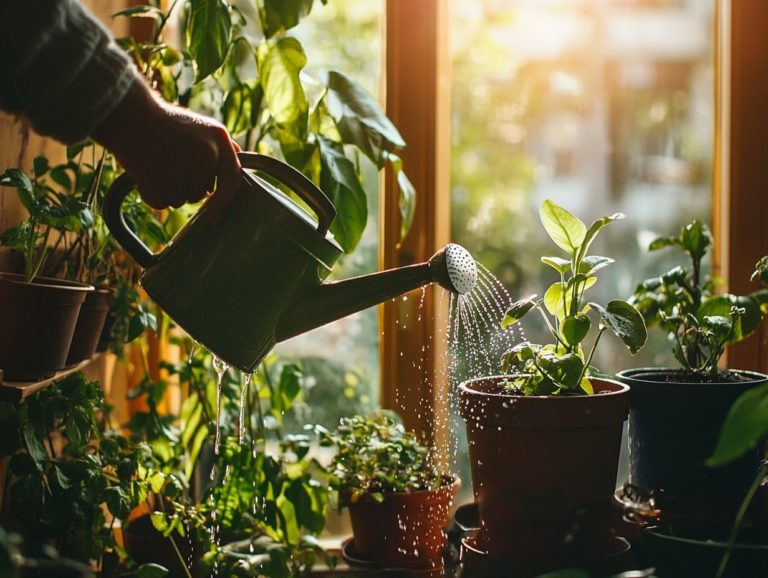How Do I Take Care of Succulents Indoors?
Succulents are the trendy choice for indoor gardening! With their striking shapes, vibrant hues, and low maintenance requirements, they make a fantastic addition to any space.
If you’re looking to enhance your living space with these hardy plants, understanding the basics of their care is crucial. This guide will equip you with the knowledge to choose the perfect succulents, cater to their lighting and watering preferences, and maintain optimal temperature and humidity levels.
You ll also explore common pest challenges and gain valuable insights on repotting and propagation, which is the process of growing new plants from cuttings. Immerse yourself in this journey to ensure your indoor oasis flourishes beautifully.
Contents
- Key Takeaways:
- Choosing the Right Succulents for Indoors
- Lighting Requirements for Indoor Succulents
- Watering and Soil for Indoor Succulents
- Temperature and Humidity Considerations
- Dealing with Pests and Diseases
- Repotting and Propagation Techniques
- Frequently Asked Questions
- What is the best way to water my succulents indoors?
- How often should I fertilize my indoor succulents?
- Can I keep my succulents in a low light area indoors?
- What is the proper temperature for indoor succulents?
- How do I prevent my indoor succulents from getting pests?
- Can I replant my succulents in a larger pot?
Key Takeaways:
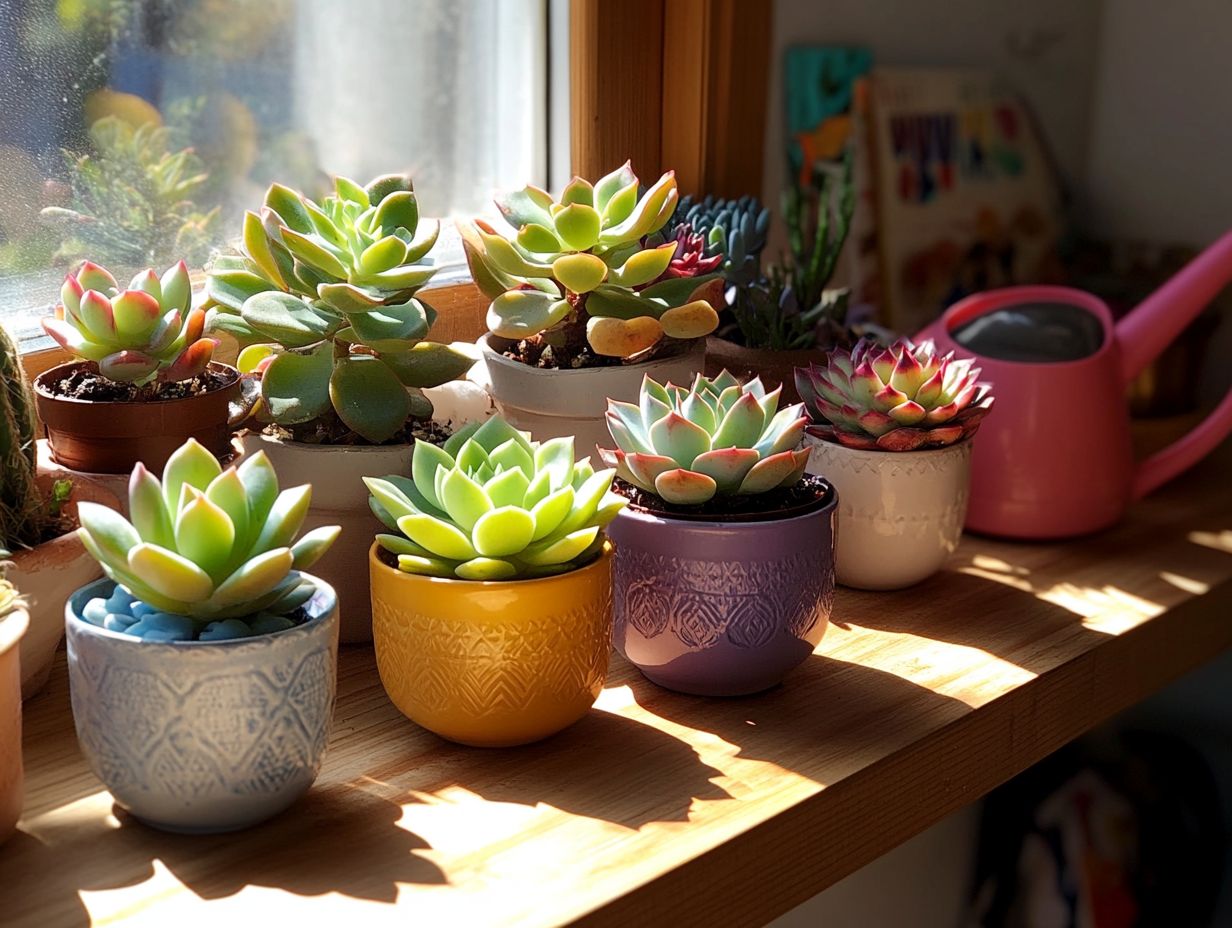
- Choose succulents based on sunlight, space, and care needs for thriving indoor plants.
- Provide adequate lighting by understanding different types of light and how to use grow lights.
- Proper watering and soil mixtures are crucial for succulent health; aim for well-draining soil and a consistent watering schedule.
Why Succulents are Great for Indoor Spaces
Succulents effortlessly thrive in various conditions while requiring minimal care. They add vibrant greenery that elevates the aesthetic appeal of any room.
With their remarkable ability to store water, these plants cater perfectly to both beginners and seasoned indoor gardening enthusiasts. Whether your space is drenched in sunlight or cozily dim, how to decorate with succulents indoors ensures they adapt seamlessly to your environment.
With a diverse array of shapes, sizes, and colors, succulents can transform any area into a lush oasis, infusing life into shelves, desks, and windowsills. They demand very little attention, needing only occasional watering and perhaps a sprinkle of fertilizer to truly thrive.
This low-maintenance quality allows you to enjoy the calming influence of greenery even amidst a busy lifestyle without feeling overwhelmed.
Perfect for anyone seeking to enhance their indoor ambiance, succulents not only improve air quality but also foster a sense of tranquility, making them a cherished choice for contemporary living.
Choosing the Right Succulents for Indoors
Choosing the right succulents for your indoor spaces requires consideration of several factors, including light availability, humidity levels, and the specific needs of each succulent species. Tailoring your choices accordingly will help keep these plants healthy and vibrant.
For beginners, popular options like Gasteria, Echeveria, Haworthia, aloe, and Crassula stand out. Each of these varieties offers unique characteristics that can flourish indoors with proper care.
Factors to Consider
When selecting the perfect succulents for your indoor garden, consider crucial factors to ensure their health and thriving. Pay attention to light exposure, humidity levels, temperature, watering needs, and airflow in the environment.
Understanding these elements will help you create an optimal habitat for your plants and avoid common pitfalls like overwatering or inadequate lighting. For succulents, it’s also important to know what to know about soil for succulents indoors, as they generally thrive in bright, indirect light; too little light can stunt their growth, while too much direct sun might scorch their delicate leaves.
Humidity levels are equally vital; these plants prefer drier air, reflecting the arid conditions of their native habitats. Maintaining a consistent temperature range is essential for their well-being, as drastic fluctuations can stress them.
Establish proper watering habits; allowing the soil to dry out completely between waterings encourages robust root systems. Ensure there is adequate airflow around the plants to prevent mold and pests, keeping them vibrant and flourishing.
Don’t miss out on the joy of indoor gardening! Start your succulent journey today and learn how to care for rare indoor plant species to transform your living space into a thriving oasis.
Lighting Requirements for Indoor Succulents
Understanding the lighting requirements for your indoor succulents is essential for their thriving success. These resilient plants flourish in bright natural light and may even appreciate direct sunlight, depending on the species.
Strategically placing them near windows that bask in ample light enhances their growth and vibrancy, creating a lush and inviting indoor garden experience.
Types of Light and How to Provide Them
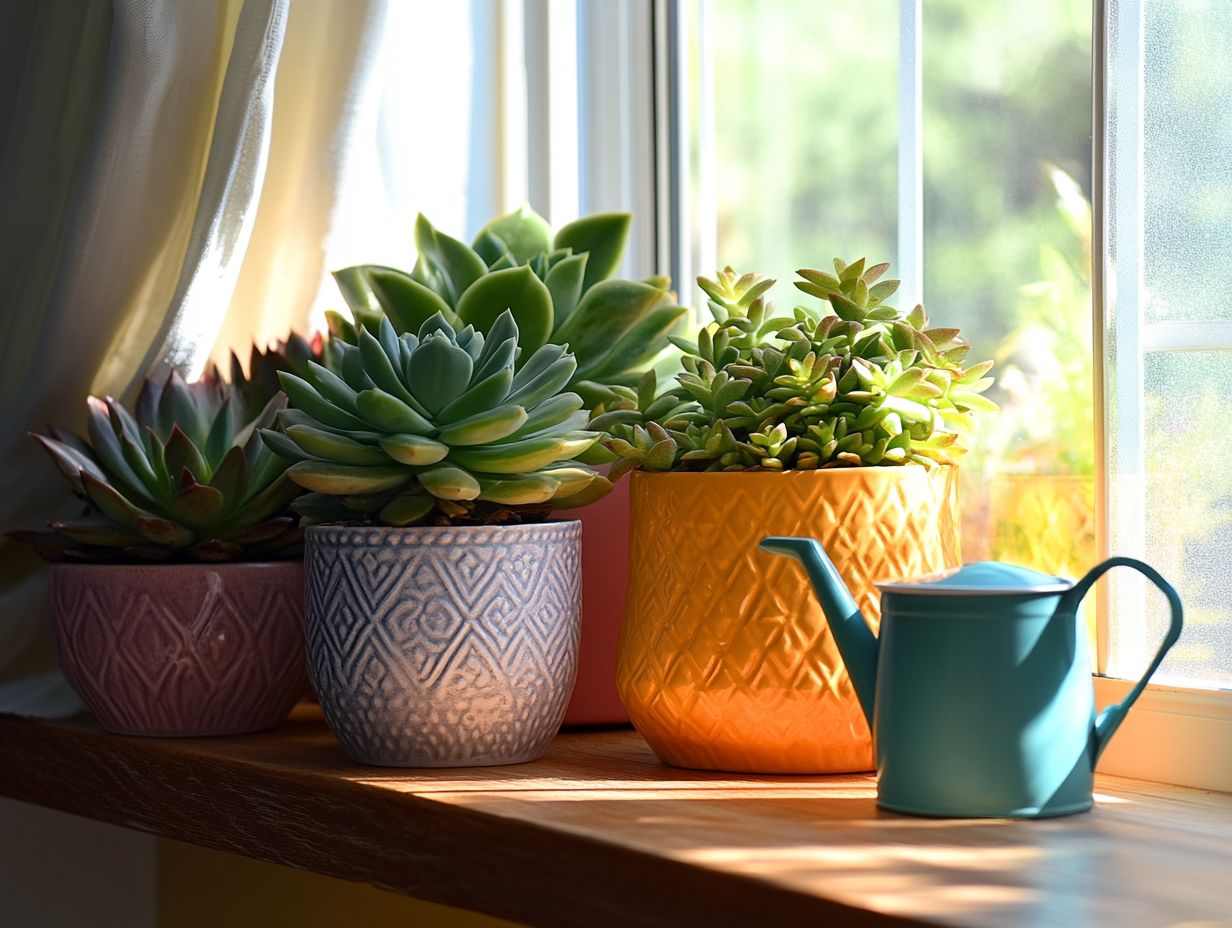
Indoor succulents need different types of light. They thrive in gentle natural light, bright ambient light, or even direct sunlight. These plants require radiant energy to flourish.
If your space lacks natural light, grow lights are a fantastic option to keep your succulents happy. It s essential to understand the specific light preferences of each succulent variety.
Some are quite particular, favoring indirect light, while others bask happily in several hours of bright, direct sunlight each day.
To create ideal lighting conditions, position your succulents near east or south-facing windows. This way, they can enjoy the gentle morning sun and avoid overheating.
In shadowy corners, adjustable grow lights can provide the perfect spectrum, mimicking natural light and ensuring your plants receive the energy they require. Start experimenting today for the best results!
Watering and Soil for Indoor Succulents
Watering and soil play crucial roles in your succulent care regimen. These unique plants have specific hydration needs and thrive in soil that allows water to pass through easily.
Mastering the art of crafting the perfect soil mixture and setting an effective watering schedule ensures that your indoor succulents remain vibrant and healthy.
Top Tips for Watering and Soil You’ll Love!
To ensure your indoor succulents thrive, establish a consistent watering schedule and use the right soil mixtures. These practices are vital for meeting their unique watering needs and preventing issues like root rot.
Choose a blend that typically includes ingredients like coarse sand, perlite, and peat moss. This combination retains moisture while promoting aeration.
Recognize the signs of overwatering, such as yellowing leaves and mushy stems, as these can quickly lead to detrimental outcomes.
By understanding the specific needs of your succulent varieties, create a tailored watering schedule that adapts to seasonal changes and environmental conditions. Incorporating these best practices, including how to maintain indoor plants in winter, will support the vitality of your indoor plants and cultivate a thriving green space that delights the eye.
Temperature and Humidity Considerations
Temperature and humidity are vital elements that significantly influence the health and growth of your indoor succulents. These plants thrive under specific conditions, and providing the right environment minimizes their stress.
Maintain optimal temperatures and humidity levels to create a nurturing atmosphere for your succulents, ensuring they remain vibrant and beautiful. For more insights, check out the best practices for indoor plant care.
Optimal Temperature and Humidity Levels for Succulents
To help your succulents flourish indoors, it s essential to maintain optimal temperature and humidity levels. These elements are crucial to their health. Indoor succulents thrive in temperatures ranging from 60 F to 80 F, with low humidity levels to prevent issues related to excess moisture.
This environment closely resembles the arid habitats where succulents naturally thrive, allowing them to store the right amount of water without succumbing to stress. Ideally, keeping humidity levels below 50% will help prevent root rot and keep the foliage vibrant.
Be mindful of extreme temperature fluctuations. For example, exposing your plants to temperatures below 50 F can shock them and stunt their growth. By monitoring these environmental factors, you can boost the vitality of your succulents, encouraging lush leaves and healthy blooms.
Dealing with Pests and Diseases

Managing pests and diseases is vital for preserving the health of your indoor succulents. Succulents are beautiful, but they can face challenges from a range of insects, like mealybugs, which can harm their vitality if not addressed quickly.
Implement effective pest control measures to protect your indoor garden. This ensures it stays free from infestations and diseases that threaten its beauty.
Common Issues and How to Address Them
Indoor succulents can face various challenges, from mealybugs to diseases threatening their growth. With the right knowledge and pest control techniques, you can act fast to keep your plants vibrant and healthy.
Watch for white, cottony clusters on leaves or stems; these indicate mealybugs. Unhealthy succulents may show signs like stunted growth, discoloration, or dropped leaves. Maintaining a proper watering schedule is essential, as overwatering can contribute to root rot and attract pests.
For pest control, diluted neem oil or insecticidal soap a natural pesticide can effectively eliminate mealybugs while preserving your plant’s health. Regular inspections and a proactive approach make a significant difference in keeping your indoor succulents thriving.
Repotting and Propagation Techniques
Repotting and propagation are crucial skills for indoor gardening enthusiasts wanting to expand their succulent collection and maintain plant health in suitable containers.
Master the timing and methods for repotting your succulents and effective propagation strategies to cultivate a flourishing indoor garden.
When and How to Repot Succulents
Knowing when and how to repot your succulents is essential for their well-being. Repotting provides fresh soil and space for growth, helping you avoid root rot and other issues. Ideally, consider repotting every 2-3 years or whenever your plants outgrow their containers.
Look for signs that it’s time to repot. If you see roots pushing through the drainage holes, notice stunted growth, or find that the soil dries out too quickly, your succulents need a change. For plants like ferns, you might want to check out how to successfully care for indoor ferns to ensure proper care.
When it s time, choose a slightly larger pot with good drainage and fill it with a well-draining cactus mix. Gently remove the plant from its current pot, shake off the old soil, and inspect the roots for rot or damage before placing it in the new pot with fresh soil. This thoughtful process revitalizes your plants and promotes vigorous growth.
Start monitoring your plants today for a healthier garden tomorrow!
Methods for Propagation and Tips for Success
Propagation is a rewarding way to expand your indoor succulent collection. With techniques like leaf and stem cuttings, you can grow healthy plants if you follow the right steps.
Understanding proper care after propagation is essential. Choose the right soil, typically a well-draining cactus mix, to control moisture and prevent root rot.
Before planting, allow your cuttings to callous. This means letting the cut ends dry out to reduce the risk of disease.
Provide the right amount of light without exposing them to harsh direct sunlight. This helps your new plants establish easily.
By paying attention to their needs, you’ll create a vibrant collection. This not only beautifies your space but also brings you joy as a plant caretaker.
Frequently Asked Questions
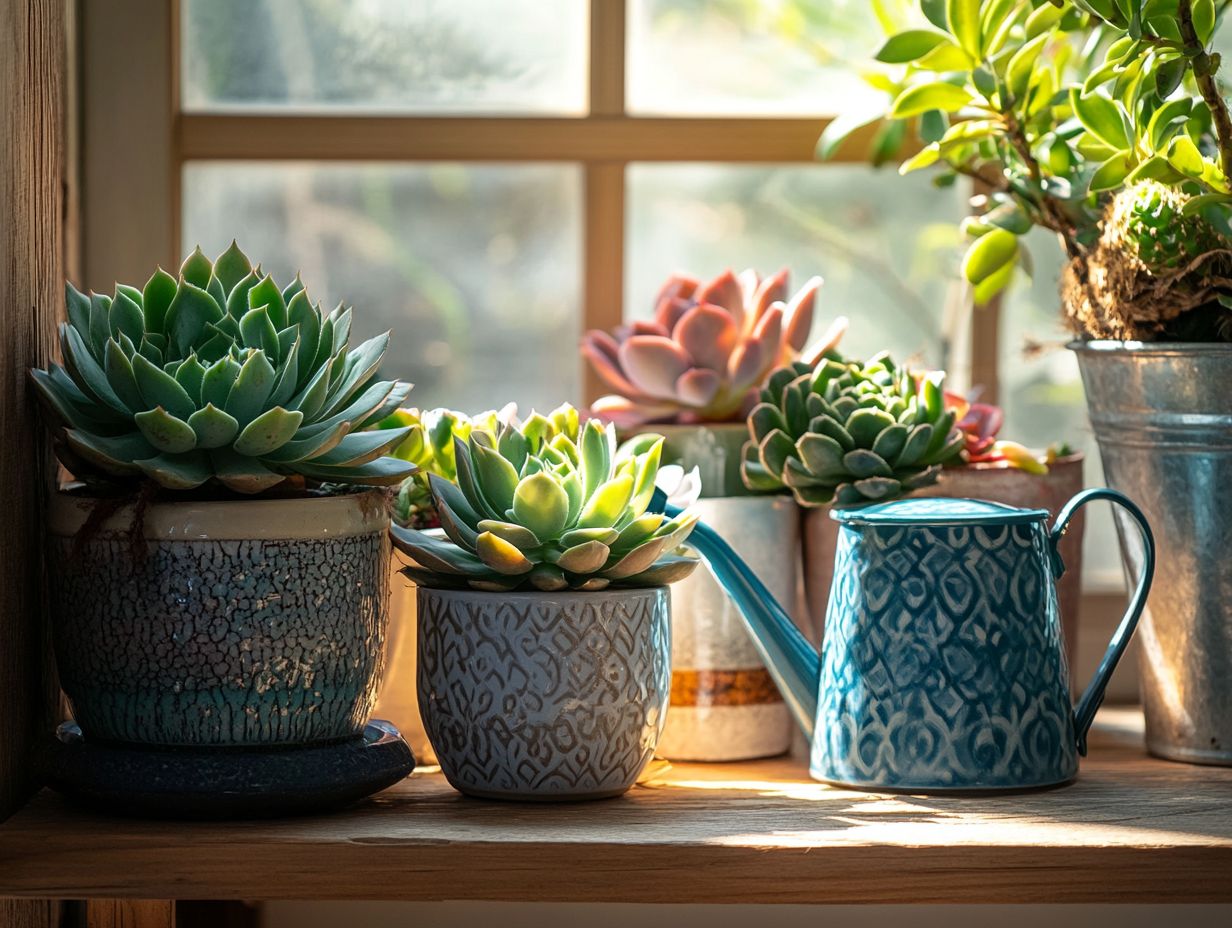
What is the best way to water my succulents indoors?
Water your succulents deeply once a week. Saturate the soil until water runs from the drainage holes, then let it dry out completely before watering again.
How often should I fertilize my indoor succulents?
Succulents need minimal fertilization. Fertilize them once every 2-3 months with a diluted succulent-specific fertilizer.
Can I keep my succulents in a low light area indoors?
Succulents prefer bright, indirect light. Place them near a window that gets at least 6 hours of sunlight daily to prevent them from becoming leggy.
What is the proper temperature for indoor succulents?
Succulents thrive in temperatures between 60-80 F (15-26 C). Keep them away from drafts and extreme temperature changes.
How do I prevent my indoor succulents from getting pests?
Regularly inspect your plants and maintain a clean environment to prevent pests. If pests appear, use a natural pest control method like neem oil.
Can I replant my succulents in a larger pot?
Yes! You can repot your succulents in a larger container if they outgrow their current one. Use well-draining soil and only increase the pot size by 1-2 inches to avoid overwatering.

